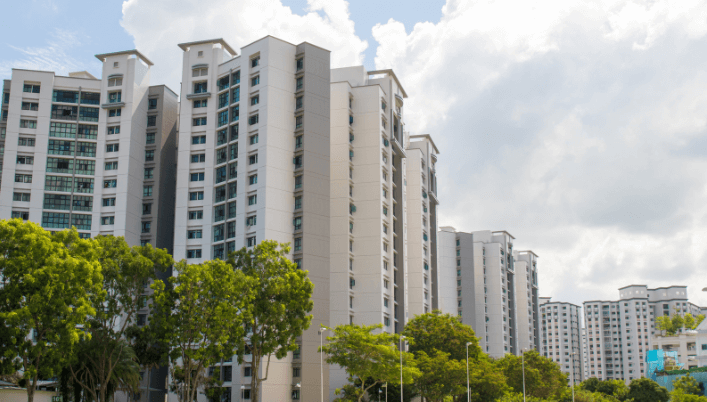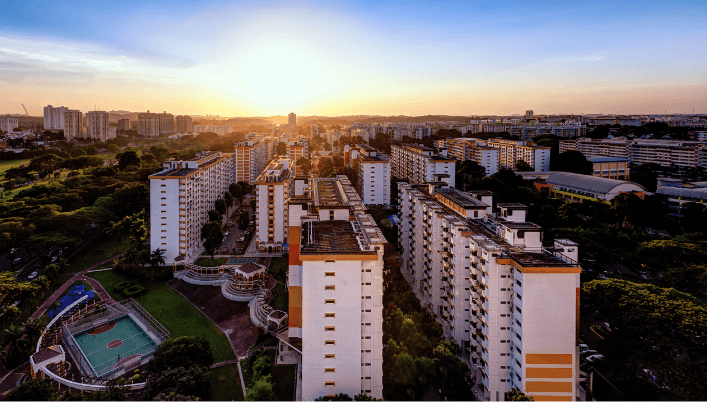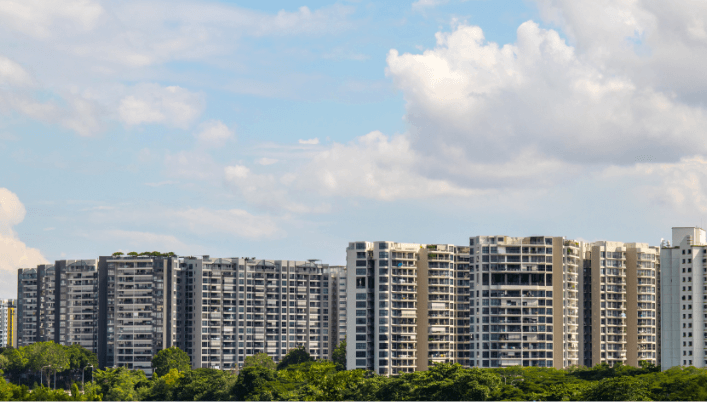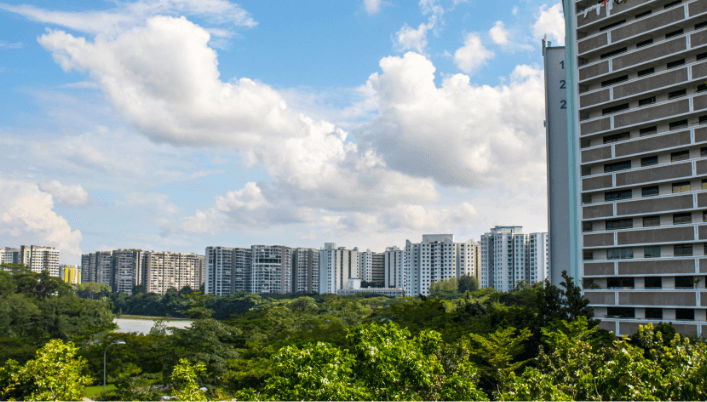Overview of Housing Estate

Definition of Housing Estate
In Singapore, a housing estate refers to a large number of houses, apartments, or buildings that form a community within a specific area.
It is developed by the Housing Development Board (HDB), which is responsible for public housing in Singapore.
Housing estates are designed to provide basic amenities and a quality living environment for residents.
These estates offer various facilities, such as recreational and community centers, parks, and other social amenities.
They aim to create a vibrant and inclusive community where residents can enjoy a comfortable living environment.
https://www.youtube.com/watch?v=CzuzxASXkMQ
Benefits of Housing Estate in Singapore

Housing estates in Singapore provide numerous benefits to residents.
Firstly, they offer easy access to essential facilities and amenities.
Residents can find parks, recreational facilities, and community centers within close proximity, promoting a healthy and active lifestyle.
Living in a housing estate also promotes social mobility and inclusivity.
People from different backgrounds and walks of life reside in these estates, fostering a diverse and vibrant community.
This social diversity contributes to Singapore’s political stability, as residents come together to establish a cohesive society.
Additionally, housing estates contribute to the overall urban planning and development of Singapore.
The town centers within these estates serve as hubs for commercial activities, with shops, markets, and amenities conveniently located for residents.
Key Features of Housing Estate in Singapore
Singapore’s housing estates boast several key features that make them stand out.
Firstly, there is a wide variety of housing options available, ranging from high-rise apartments to landed properties.
This diversity caters to different needs and preferences, ensuring that residents can find a home that suits their lifestyle.
The estates are also strategically planned with urban design in mind.
They often incorporate green spaces, parks, and waterfront towns, creating a harmonious balance between urban living and nature.
Architectural features are carefully considered to create visually appealing and functional spaces.
Furthermore, housing estates are well-connected through efficient transportation systems.
Each etate typically has a bus interchange or MRT station, enabling residents to easily travel to other parts of Singapore.
Singapore’s housing estates provide residents with a conducive and inclusive living environment.
They offer a range of facilities, promote social mobility, and contribute to the overall urban planning and development of the city-state.
Living in a housing estate in Singapore ensures a quality lifestyle and a sense of community.
Key Takeaways
- Definition of Housing Estate: Housing estates in Singapore, developed by the Housing Development Board (HDB), aim to provide a vibrant and inclusive community with easy access to amenities.
- Benefits of Housing Estate: Residents enjoy proximity to essential facilities, social diversity fostering political stability, and contributions to urban planning and development.
- Key Features of Housing Estate: Diverse housing options, strategic urban planning, well-connected transportation, and a harmonious balance between urban living and nature.
- Types of Houses in Singapore: Flats (HDB), Private Condominiums, Landed Houses, Executive Condominiums, Cluster Houses, and Shophouses cater to diverse preferences.
- Examples of Housing Estates: HDB Estates (e.g., Toa Payoh), Private Housing Estates (e.g., Albert Park), Mixed-Use Estates (e.g., Punggol), and Older Estates (e.g., Ang Mo Kio).
- Current Housing Trends: Emphasis on high-density housing, suburban development, sustainable living, inclusive environments, 10-year Minimum Occupation Period, and transformation into activity hubs.
- Factors Influencing Housing Trends: Government policies, market conditions, affordability, leasehold schemes, and integration of amenities shape housing trends.
- Introduction to HDB: The Housing Development Board (HDB) is a key government organization ensuring affordable and well-planned housing estates.
- HDB Flats for Sale and Rent: HDB offers various flats with leasehold properties, advanced building technologies, and sustainability features.
- Checking Housing Prices: Utilize HDB website, property portals, real estate agents, newspapers, and magazines to check housing prices and rental rates.
Types of Houses in Singapore
Different types of houses in Singapore
Singapore offers a diverse range of housing options to cater to different preferences and needs.
Here are some common types of houses you can find in the city-state:
- Flats: Flats are the most common type of housing in Singapore. They are usually part of public housing estates developed by the Housing and Development Board (HDB). Flats can range from studio apartments to multi-room units and often come with communal facilities.
- Private Condominiums: These are privately-owned residential developments that offer a range of facilities such as swimming pools, gyms, and playgrounds. Private condominiums are typically larger and more luxurious than HDB flats.
- Landed Houses: Landed houses refer to single-family homes that are built on private land. They come in various forms, including terrace houses, semi-detached houses, and bungalows. Landed houses offer more privacy and space compared to flats or condominiums.
- Executive Condominiums: Executive condominiums (ECs) are a hybrid of public and private housing. They are developed and sold by private developers but are subject to certain eligibility criteria and resale restrictions for a specified period of time.
- Cluster Houses: Cluster houses are a type of housing that combines the privacy and space of landed houses with the amenities and security of condominiums. These houses are usually built in small clusters and come with shared recreational facilities.
- Shophouses: Shophouses are traditional Singaporean houses that have businesses on the ground floor and residential units on the upper floors. They are typically found in heritage areas and offer a unique blend of commercial and residential spaces.
Examples of housing estates in Singapore
Singapore is known for its well-planned and vibrant housing estates.
Some popular examples include:
1- HDB Estates: The Housing and Development Board (HDB) is responsible for developing and managing public housing in Singapore. HDB estates, such as Toa Payoh, Tiong Bahru, and Ang Mo Kio Town, are well-known for their well-designed flats, community facilities, and amenities.
2- Private Housing Estates: Private housing estates like Albert Park and Leedon Park offer a range of residential options, including condominiums, landed houses, and cluster houses. These estates often feature landscaped gardens, swimming pools, and other exclusive facilities.
3- Mixed-Use Estates: Some housing estates, such as Punggol and Jurong East, are developed as mixed-use estates. These estates combine residential, commercial, and recreational spaces to create self-contained communities where residents can live, work, and play.
4- Older Estates: Older housing estates like Ang Mo Kio and Toa Payoh are known for their unique architectural features, such as void decks and open communal spaces. These estates also have a rich history and vibrant community life.
It’s important to note that housing prices and availability can vary depending on factors such as location, lease tenure, and market conditions. For information on specific housing developments, it’s recommended to check official sources like the Housing and Development Board’s website or consult with reputable real estate agents for the most up-to-date and accurate information.
Housing Trends in Singapore
Current Housing Trends in Singapore
Singapore’s housing landscape is constantly evolving to meet the demands of its growing population.
Here are some current housing trends in Singapore:
- Development of High-Density Housing: Due to limited land availability, Singapore has seen a rise in high-density housing developments. Private developers are constructing condominiums and mixed-use developments to cater to the increasing demand for housing.
- Ownership Located in Suburban Areas: Many new housing developments are located in suburban areas, offering residents a quieter and more spacious living environment away from the hustle and bustle of the city center.
- Focus on Sustainable Living: Singapore is committed to sustainable living, and this is reflected in the design of new housing developments. Developers are incorporating green features such as energy-efficient appliances, rainwater harvesting systems, and rooftop gardens to create a more environmentally friendly living environment.
- Inclusive Living Environment: The Housing and Development Board (HDB) has been actively promoting inclusivity in its housing developments. Features such as barrier-free access, elderly-friendly amenities, and childcare centers are being incorporated to create a more inclusive living environment for residents of all ages.
- 10-Year Minimum Occupation Period (MOP): To ensure stability in the housing market, new HDB flats and executive condominiums (ECs) have a 10-year MOP. This means that owners are required to live in the property for at least 10 years before they can sell or rent it out.
- Transformation into Activity Hubs: Singapore is transforming certain neighborhoods into activity hubs, where residents can live, work, and play. These hubs feature a mix of residential, commercial, and recreational facilities, creating vibrant and self-contained communities.
- Additional Housing Programmes: In addition to HDB flats, the government has introduced alternative housing options such as Rental Housing and Assistive Living Flats for seniors, providing more choices for different segments of the population.
Factors Influencing Housing Trends
Several factors influence housing trends in Singapore:
- Housing Policy: The government plays a crucial role in shaping housing trends through its policies. The Housing and Development Board (HDB) develops and regulates public housing, while private developers contribute to the private housing market.
- Price and Rental Market: Housing prices and rental rates are significant factors that influence housing trends. Market conditions, supply and demand dynamics, and government intervention in the form of subsidies and grants affect the affordability and availability of housing options.
- Leasehold and Subsidy Schemes: Most public housing in Singapore is leasehold, with lease terms ranging from 99 to 999 years. The government also provides subsidies and grants to make housing more affordable for eligible Singaporeans.
- Alternative Housing Options: The government has introduced additional subsidies and schemes, such as the Step-Up CPF Housing Grant and Enhanced CPF Housing Grant, to help first-time buyers and families with their housing needs.
- Town Councils and Maintenance: Town councils are responsible for maintaining and managing public housing estates, ensuring that residents are provided with clean and well-maintained living environments.
- Integration of Amenities and Facilities: Housing trends are influenced by the availability of amenities and facilities within the vicinity of housing estates. The integration of schools, healthcare facilities, parks, and shopping centers contributes to the desirability of certain housing developments.
Housing trends in Singapore are shaped by various factors, including government policies, market conditions, affordability, and the desire for sustainable and inclusive living environments.
These trends reflect the city-state’s commitment to providing quality housing options for its residents.
Singapore Housing Development Board (HDB)

Introduction to the Housing Development Board (HDB)
The Housing Development Board (HDB) is a government organization in Singapore responsible for public housing.
Established in 1960, the HDB has played a crucial role in providing affordable housing for Singaporeans.
It is both a developer and regulator, ensuring that housing estates are well-maintained and meet the needs of residents.
The HDB manages a comprehensive archive of information on housing in Singapore, making it a valuable reference for those looking to browse the available options.
They serve as a reliable source of information about current housing trends, developments, and regulations.
Additionally, the HDB works closely with town councils to ensure that housing estates are properly managed, giving residents a secure and pleasant living environment.
Singapore is known for its well-planned housing estates, with the HDB having developed 23 self-contained new towns.
These towns are designed to provide residents with all the necessary amenities, such as schools, healthcare facilities, parks, and shopping centers.
Each town is meticulously planned and maintained by the HDB to create a comfortable and convenient living environment.
The HDB is constantly exploring innovative housing solutions to meet the evolving needs of Singaporeans.
From planning new developments to implementing co-operative housing schemes, the HDB aims to provide quality housing that is affordable for all.
https://www.youtube.com/watch?v=ya-pdE-wH-k
HDB flats for sale and rent
The HDB offers a range of flats for sale and rent, providing various options to suit different requirements.
HDB flats are leasehold properties, with lease terms ranging from 99 to 999 years.
This ensures that homeowners have secure long-term tenure.
For those looking to buy an HDB flat, they can source available units through the HDB website or engage the services of an HDB salesperson.
The website provides detailed information about each development, including the facilities and amenities available.
Renting an HDB flat is also a popular option.
The HDB offers different rental schemes, including the Flexi Scheme, which allows residents to rent on shorter lease terms.
There are also commercial facilities available within certain HDB developments, providing convenience for residents.
To make housing more affordable, the HDB offers additional subsidies for eligible buyers, such as the Enhanced CPF Housing Grant.
The HDB also introduced the 2-room Flexi Scheme, which caters to eligible singles of different age groups.
These initiatives provide more options and flexibility for individuals and families looking to secure housing.
The HDB is known for its use of advanced building technologies and sustainable design practices.
This ensures that HDB flats are not only affordable but also environmentally friendly.
These initiatives contribute to the overall desirability of HDB flats and make them an attractive housing option in Singapore.
The Housing Development Board (HDB) plays a vital role in providing affordable and well-planned housing estates in Singapore.
With a wide range of options for sale and rent, along with additional subsidies and flexible schemes, the HDB aims to cater to the diverse housing needs of Singaporeans.
Their commitment to sustainable design and advanced building technologies ensures that HDB flats are not only affordable but also environmentally friendly.
Checking Housing Prices and Rental Rates

Sources to Check Housing Prices and Rental Rates
When it comes to finding the perfect house or apartment in Singapore, it’s important to have access to reliable information on housing prices and rental rates. Fortunately, there are several sources you can turn to for this valuable data.
- Housing Development Board (HDB) Website: The HDB website is a great starting point for checking housing prices and rental rates in Singapore. They provide comprehensive information on various types of housing, including HDB flats, executive condominiums, and private properties. You can browse through their listings and get an idea of the price range for different types of properties.
- Property Portals: There are several property portals in Singapore that offer up-to-date information on housing prices and rental rates. Popular portals include PropertyGuru, 99.co, and SRX Property. These websites allow you to search for properties based on your preferences and budget, and provide detailed information on each listing, including the asking price or rental rate.
- Real Estate Agents: Engaging the services of a real estate agent can also be a helpful way to check housing prices and rental rates. These professionals have access to a wide range of properties and can provide you with accurate information on current market rates. They can also assist you in finding the right property based on your specific needs and budget.
- Newspapers and Magazines: Local newspapers and magazines often publish property listings and articles on housing trends in Singapore. These publications can provide insights into the current market conditions and give you an idea of the average housing prices and rental rates in different areas.
How to Secure a Housing Unit
Securing a housing unit in Singapore involves several steps to ensure a smooth and secure transaction.
Here are some key points to consider:
- Understanding Leasehold: In Singapore, most properties are leasehold, which means they are owned for a fixed period of time, typically between 99 to 999 years. It’s important to understand the lease terms and the implications they may have on your ownership and resale options.
- Approval and Voting: For HDB flats, there are certain eligibility requirements and procedures to follow. This includes meeting the eligibility criteria for purchasing an HDB flat and obtaining approval from the HDB. In certain cases, resale buyers may also need to participate in a ballot or ballot for a unit.
- Building Societies and Advanced Technologies: To ensure the quality and sustainability of homes in Singapore, the HDB adopts advanced building technologies and incorporates green features in their developments. These initiatives contribute to the overall desirability and livability of HDB flats.
- Additional HDB Schemes: The HDB offers various schemes and grants to make housing more affordable for Singaporeans. For example, the 2-room Flexi Scheme caters to eligible singles, offering flexibility in terms of lease duration. Eligible buyers can also benefit from the Enhanced CPF Housing Grant and other subsidies.
Securing a housing unit in Singapore requires careful consideration and research.
By checking housing prices and rental rates from reliable sources and understanding the procedures involved, you can make an informed decision and find a quality home that meets your needs.
Schools in Singapore Housing Estates
Singapore housing estates not only provide a place to live but also offer a range of amenities and facilities, including schools.
These schools play a vital role in the lives of residents, creating a sense of community and providing accessible education options.
Whether you are a young family looking for a school for your children or an elderly resident interested in lifelong learning, Singapore’s housing estates have something to offer.
Schools located within housing estates
Many housing estates in Singapore have schools located within or nearby, making it convenient for residents to access quality education.
These schools cater to different age groups and provide a wide range of educational programs.
From preschools and primary schools to secondary schools and junior colleges, there are options available for every stage of a child’s academic journey.
Apart from the traditional education system, housing estates also have community-centric schools that focus on specific needs or interests.
For example, there are schools that specialize in the arts, sports, or technical skills.
These schools provide specialized training and education, allowing students to explore their passions and talents.
Schools within housing estates not only serve the residents but also contribute to the overall development of the community.
They act as a focal point for resident activities, bringing families together and fostering a sense of belonging.
They also serve as community living spaces, creating opportunities for intergenerational interactions, such as elderly residents engaging with younger students.
In addition to schools within the housing estates, there are also public and private educational institutions located nearby.
This ensures that residents have a wide range of educational choices and access to quality education.
Translation and Reference for Housing Terminology
For non-English speakers or those unfamiliar with housing terminology, it is essential to have translation and reference resources available.
The Housing Development Board (HDB) website provides comprehensive information in multiple languages, including Chinese, Malay, and Tamil.
This allows residents to understand and navigate the housing-related terms and processes easily.
In addition to the HDB website, there are various translation services and language apps available that can assist with understanding housing terminology.
These resources can be helpful for individuals who are new to Singapore or are not familiar with the local housing system.
Overall, the presence of schools within Singapore’s housing estates enhances the quality of life for residents.
It provides convenience, fosters community engagement, and ensures that residents have access to quality education options.
Whether you are a parent, a student, or an elderly resident interested in lifelong learning, Singapore’s housing estates offer a range of schooling opportunities to meet your needs.
Singapore’s housing estates are not just places to live, but they also offer a range of amenities and facilities, including schools.
These schools have a significant impact on the lives of residents, creating a sense of community and providing accessible education options.
Whether you are a young family looking for a school for your children or an elderly resident interested in lifelong learning, Singapore’s housing estates have something to offer.
Schools located within housing estates
Many housing estates in Singapore have schools located within or nearby, making it convenient for residents to access quality education.
These schools cater to different age groups and provide a wide range of educational programs.
From preschools and primary schools to secondary schools and junior colleges, there are options available for every stage of a child’s academic journey.
In addition to the traditional education system, housing estates also have community-centric schools that focus on specific needs or interests.
For example, there are schools that specialize in the arts, sports, or technical skills.
These schools provide specialized training and education, allowing students to explore their passions and talents.
Moreover, schools within housing estates do not just serve the residents but also contribute to the overall development of the community.
They act as a focal point for resident activities, bringing families together and fostering a sense of belonging.
They also serve as community living spaces, creating opportunities for intergenerational interactions, such as elderly residents engaging with younger students.
Furthermore, in addition to schools within the housing estates, there are public and private educational institutions located nearby.
This ensures that residents have a wide range of educational choices and access to quality education.
For non-English speakers or those unfamiliar with housing terminology, it is essential to have translation and reference resources available.
The Housing Development Board (HDB) website provides comprehensive information in multiple languages, including Chinese, Malay, and Tamil.
This allows residents to understand and navigate the housing-related terms and processes easily.
The presence of schools within Singapore’s housing estates enhances the quality of life for residents.
It provides convenience, fosters community engagement, and ensures that residents have access to quality education options.
Whether you are a parent, a student, or an elderly resident interested in lifelong learning, Singapore’s housing estates offer a range of schooling opportunities to meet your needs.
Conclusion
Summary of key points discussed throughout the blog post
Throughout this blog post, we have explored the importance of branding and how it can differentiate your business from competitors.
We have learned that branding goes beyond creating a logo and slogan; it is about developing a strong and reliable brand identity that resonates with your target audience.
By showcasing your business’s distinctiveness through values, story, brand promise, and other assets, you can create a point of difference that sets you apart.
We have also discussed the ways in which you can utilize branding to effectively promote your business.
Developing a clear brand strategy, building a strong online presence, and delivering exceptional customer experience are all essential aspects of successful branding.
These strategies help establish a recognizable brand that connects with customers on an emotional level.
Additionally, we have provided some best examples of companies that have successfully utilized branding.
Apple, Nike, and Coca-Cola are prime examples of brands that have effectively communicated their values, unique selling propositions, and quality through consistent messaging and captivating visual identity.
They have created strong emotional connections with their customers, leading to their success in the market.
Reflection on the effectiveness of Singapore’s housing estate approach
Singapore’s approach to housing is considered exemplary worldwide.
The public housing programme, known as Housing Development Board (HDB), has played a crucial role in providing affordable and quality housing for Singaporeans.
The approach focuses on creating cohesive communities, promoting social cohesion, and ensuring that housing is not just a tangible asset but also a reflection of national objectives.
One key aspect of Singapore’s housing estate approach is the integration of social facilities and amenities within the town centres.
This integrated approach ensures that residents have easy access to essential services like healthcare, education, and recreation, fostering a sense of community and convenience.
Fitness corners, playgrounds, and community spaces are designed to encourage community participation and a healthy lifestyle.
Another significant aspect is the provision of public housing flats for first-timer families.
The government’s housing subsidies and various flat types, including the affordable 2-room Flexi flats, cater to the diverse needs of different income groups.
This ensures that housing is accessible and affordable for all, promoting social inclusivity.
Singapore’s housing estate approach also involves careful planning and land assembly to maximize land use efficiently.
The development of resale flats in the housing market provides a steady supply of affordable housing, catering to the changing needs of residents.
The government’s strict regulations on resale prices ensure that housing remains affordable and prevents speculation.
Overall, Singapore’s housing estate approach has been highly effective in addressing the housing crisis and promoting social cohesion.
The integrated approach, focus on community participation, and commitment to providing affordable housing have resulted in cohesive communities and a high resident population satisfaction rate.
As a result, Singaporeans view their public housing as not just a place to live but also a reflection of their identity and pride in their nation.
A housing estate definition a large area, typically made up of numerous residential buildings, where people live in a community.
These estates are usually planned and developed with a specific purpose in mind, such as providing affordable housing or accommodating a particular group of people.
The buildings within housing estates are typically built close together, often forming a tight-knit community where residents connect and interact with each other.
Different types of housing can be found within these estates, including condominiums, apartments, townhouses, or detached houses.
Some housing estates are developed by private developers, while others are managed by government authorities such as the Housing and Urban Development Corporation (HUDC).
Subdivision is often used interchangeably with housing estate, referring to the division of a larger piece of land into smaller plots or lots for housing.
With the increase in urbanization and population growth, the development of well-planned and sustainable housing estates has become crucial for meeting the housing needs of the community.
The industrial sector plays a crucial role in powering economies around the world.
It serves as the avenue for growth, providing job opportunities and contributing to the development of infrastructure.
However, the rapid expansion of industrial activities often poses risks on the quality of dwelling for individuals living in proximity to these areas.
As a responsible government, it becomes imperative for the relevant ministries and agencies to address these concerns.
The Ministry of Environment, in particular, should closely monitor and regulate industrial activities to minimize their impact on sensitive residential areas.
Additionally, the government should subsidize the development of cleaner and more sustainable technologies to ensure the earliest possible transition towards a greener industrial landscape.
While the primary objective of industrial growth is economic, it is essential to strike a balance and also promote leisure and entertainment options for the well-being of the population.
Hence, investments should be made in the retail and entertainment sectors to create a concrete division between work and leisure, fostering a healthier work-life balance.
World War II was a catastrophic event that caused immense destruction and loss of life.
The war, which lasted from 1939 to 1945, saw the rise of opposing forces that constituted the Allied Powers and the Axis Powers.
The conflict brought about significant changes to the global political landscape and resulted in the remaking of nations and boundaries.
It is estimated that over 80 million people lost their lives during this period, leaving behind a trail of devastation that would take years to repair.
As cities were reduced to rubble and infrastructure was destroyed, the task of rebuilding became a pressing concern.
Flats were built to accommodate the growing populations affected by the war, providing shelter for those who had lost their homes.
However, gaining approval for these new structures often faced opposition from those who believed that the old ways of life should be preserved.
Nevertheless, the need for housing prevailed, and these flats played a crucial role in the post-war reconstruction efforts.
The war not only flushed away lives but also reshaped the world and necessitated the construction of new roofs to provide a home for the displaced.
In conclusion, branding is a powerful tool that can differentiate your business and establish a strong connection with your target audience.
By developing a clear brand strategy, creating a strong online presence, and delivering exceptional customer experience, you can build a successful brand that stands out in a competitive market.
The best examples, such as Apple, Nike, and Coca-Cola, demonstrate how consistent branding can create a strong emotional connection with customers.
Similarly, Singapore’s housing estate approach has effectively addressed the housing crisis and promoted social cohesion through its integrated approach, affordable housing options, and focus on community participation.
Frequently Asked Questions
What is a housing estate?
A housing estate is a large area of land on which multiple residential buildings, known as blocks, are built together.
Can you provide an example of a housing estate?
An example of a housing estate is the public housing estates in Hong Kong.
How can I browse housing estates?
You can browse housing estates by visiting real estate websites or contacting local estate agents for information on available properties.
Is it possible to buy a flat in a housing estate sale?
Yes, flats in housing estates can be purchased either from the primary market directly from the developer or from the secondary market through resale transactions.
Can I rent a flat in a housing estate?
Yes, flats in housing estates can be rented from the owners or through property management companies.
Where can I source information about housing estates?
You can source information about housing estates from real estate websites, local newspapers, or by contacting the relevant housing authorities.
What does the term "translation" mean in the context of housing estates?
In the context of housing estates, the term “translation” refers to the process of converting text or information from one language to another.
Is there any specific reference material available for understanding housing estates?
Yes, you can refer to official documents, housing estate guides, or publications by housing authorities for detailed information about housing estates.
How are housing estates secured?
Housing estates are secured through various measures such as gated entrances, CCTV surveillance, and security personnel to ensure the safety and well-being of residents.
What is the definition of a housing estate according to the English dictionary?
According to the English dictionary, a housing estate is a large area of land on which many houses or flats are built together.












